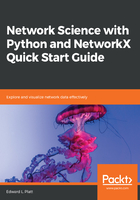
Visualizing networks
Networks are often visualized by drawing a dot or circle for each node and a line for each edge, as in the following diagram:

Looking at the network in this diagram, you might as yourself where to draw the nodes. The answer is wherever you want! (Although technically possible, it might be advisable to avoid hot surfaces, the mouths of large predatory animals, and/or important historical documents.) Because networks are meant to focus on structure and connectivity, there are many ways to draw the same network. Nodes can be drawn anywhere. Edges can be straight or squiggly, long or short. Edges can even cross, but that should never be interpreted as being connected to each other!
The same network can be drawn in many other ways, as shown in the following diagram. The nodes have been labelled with letters to make it easier to compare between different network diagrams. Regardless of which diagram you look at, any particular node will be connected to the same set of other nodes. While different ways of drawing the same network are equally correct, some may be helpful at highlighting particular features of the network. Chapter 11, Visualization, describes common approaches to visualizing networks and their various applications:
